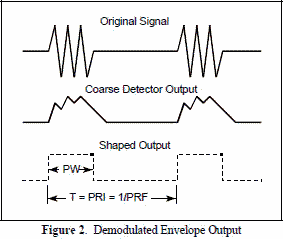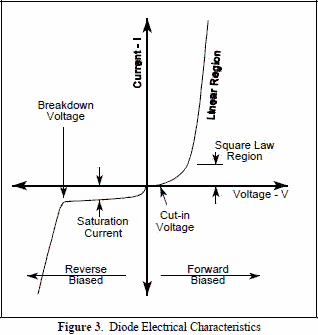Electronic Warfare and Radar Systems Engineering Handbook |
||||||||||||
|
DETECTORS A detector is used in receiver circuits to recognize the presence of signals. Typically a diode or similar device is used as a detector. Since this type of detector is unable to distinguish frequency, they may be preceded by a narrow band-pass filter. A typical simplistic circuit is shown in Figure 1.
Figure 1. Typical Diode Detector Circuit
When the diode is reverse biased, very little current passes through unless the reverse breakdown voltage is exceeded. When forward biased and after exceeding the cut-in voltage, the diode begins to conduct as shown in Figure 3. At low voltages, it first operates in a square law region. Detectors operating in this region are known as small signal type. If the voltage is higher, the detector operates in a linear region, and is known as the large signal type.
The power/voltage characteristics for a typical diode detector is shown in Figure 4. Square Law Detector
In the square law region, the output voltage Vo is proportional to the square of the input voltage Vi, thus Vo is proportional to the input power. Vo = nVi2 = nPi or Pi is proportional to Vo Where n is the constant of proportionality Linear Detector In the linear detection region, the output voltage is given by: Vo = mVi and since P=V /R, Pi is proportional to Vo Where m is the constant of proportionality
Log Detector Amplifier Another type of detector arrangement is the Log detector amplifier circuit shown in Figure 5. It is formed by using a series of amplifiers and diode detectors. Due to the nature of the amplifier/diode characteristics, the output voltage is related to the power by: Pi is approximately equal to 10pVo + q Where p and q are constants of proportionality The Log detector has good range, but is hampered by large size when compared to a single diode detector. Pulse Width Measurements If the pulse width of a signal was specified at the one-half power point, the measurements of the detected signal on an oscilloscope would vary according to the region of diode operation. If the region of operation is unknown, a 3 dB attenuator should be inserted in the measurement line. This will cause the power to decrease by one-half. That point on the oscilloscope becomes the measurement point for the pulse width when the external 3 dB attenuator is removed.
These voltage levels for half power using the three types of detectors are shown in Table 1.
Table 1. Detector Characteristics
Dynamic Range Small dynamic range Greater dynamic range Greatest dynamic range (to 80 dB) Also see Section 6-10, Microwave / RF Testing, subsection entitled "Half Power or 3 dB Measurement Point".
Table of Contents for Electronics Warfare and Radar Engineering Handbook Introduction | Abbreviations | Decibel | Duty Cycle | Doppler Shift | Radar Horizon / Line of Sight | Propagation Time / Resolution | Modulation | Transforms / Wavelets | Antenna Introduction / Basics | Polarization | Radiation Patterns | Frequency / Phase Effects of Antennas | Antenna Near Field | Radiation Hazards | Power Density | One-Way Radar Equation / RF Propagation | Two-Way Radar Equation (Monostatic) | Alternate Two-Way Radar Equation | Two-Way Radar Equation (Bistatic) | Jamming to Signal (J/S) Ratio - Constant Power [Saturated] Jamming | Support Jamming | Radar Cross Section (RCS) | Emission Control (EMCON) | RF Atmospheric Absorption / Ducting | Receiver Sensitivity / Noise | Receiver Types and Characteristics | General Radar Display Types | IFF - Identification - Friend or Foe | Receiver Tests | Signal Sorting Methods and Direction Finding | Voltage Standing Wave Ratio (VSWR) / Reflection Coefficient / Return Loss / Mismatch Loss | Microwave Coaxial Connectors | Power Dividers/Combiner and Directional Couplers | Attenuators / Filters / DC Blocks | Terminations / Dummy Loads | Circulators and Diplexers | Mixers and Frequency Discriminators | Detectors | Microwave Measurements | Microwave Waveguides and Coaxial Cable | Electro-Optics | Laser Safety | Mach Number and Airspeed vs. Altitude Mach Number | EMP/ Aircraft Dimensions | Data Busses | RS-232 Interface | RS-422 Balanced Voltage Interface | RS-485 Interface | IEEE-488 Interface Bus (HP-IB/GP-IB) | MIL-STD-1553 & 1773 Data Bus | This HTML version may be printed but not reproduced on websites. |
||||||||||||

 To
integrate a pulse radar signal, we can add capacitance to the circuit in parallel with the output load RL to store energy and decrease the bleed
rate. Figure 2 shows a typical input/output waveform which detects the envelope of the pulse radar signal. From this information pulse width
and PRF characteristics can be determined for the RWR UDF comparison.
To
integrate a pulse radar signal, we can add capacitance to the circuit in parallel with the output load RL to store energy and decrease the bleed
rate. Figure 2 shows a typical input/output waveform which detects the envelope of the pulse radar signal. From this information pulse width
and PRF characteristics can be determined for the RWR UDF comparison. 